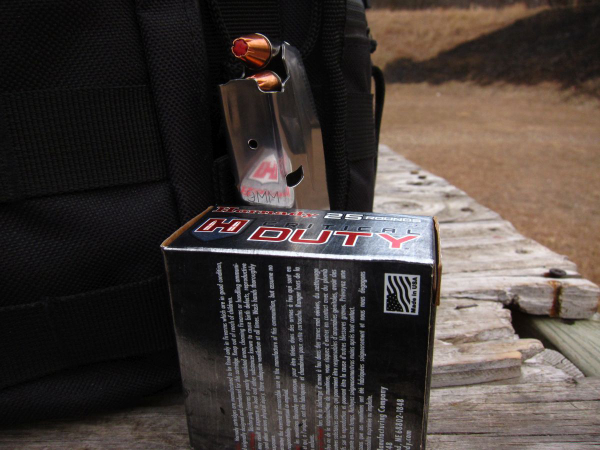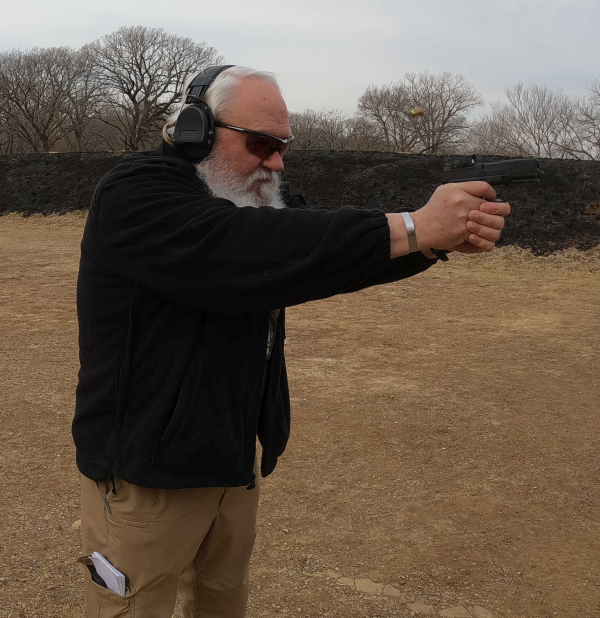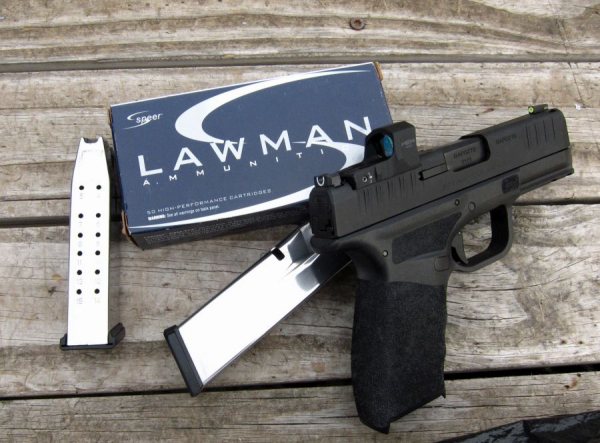Last Friday, you saw Jim’s assessment of the new Hellcat Pro pistol from Springfield Armory. I’d received a sample of the pistol, fitted from the factory with the HEX Wasp optic, about mid-week and fired a few rounds from it before the gun was announced.
I’m glad the optic was attached to prevent overuse of my meager mechanical skills, but the gun is sold optics-ready, not (far as I know) with optics mounted.
I have since shot the gun more and have some information.

My first try was only at seven yards – even knowing that a close-range event like that says nearly nothing about whether the optic is zeroed. Those first rounds fired two-handed stayed within the “X” ring of the NRA B-8 bullseye repair center target. Firing five rounds “wrong hand” unsupported and another five right-hand, unsupported and all rounds were in the 10-ring of the B-8 – except for a “convulsive clutch” throwing a single out into the “8”ring.
Getting back out with a small collection of ammo, I sought to shoot groups with the new heater so see if it was really a shooter. The bench was set at 20 yards and I used a range bag for support. I quickly found I was pressing left – shooting at a silhouette from fifty yards showed a pair of rounds within 1 ½” of each other, but all the way to the left edge of the paper.
After shooting groups, I sought to actually zero the HEX Wasp optic. In a moment, I had the round hitting to the right of aim – there are no “click” adjustments on the optic. Bringing it back to the left put the hits center which I later confirmed on a “walk-back” drill.


In the accuracy test, I found the winner (for these particular loads) was the DoubleTap 115 grain Barnes “TAC-XP” load. It put five hits into 2 1/8” with the best three hits crowding into an inch. Federal Syntech Defense 138gr. JHP tied for second place with Remington Golden Saber 124gr. BJHP. Both rounds produced four-inch groups, the Federal being a vertical string that causes me to question my grip – not the load or ammo. The Federal load put three of those into 2 ½” while the Golden Saber slightly bettered the performance with four hits into 1 3/8”.
I think this Hellcat Pro prefers light-to-midweight 9mm bullets – so far. The Hornady Critical Duty 135gr. FTX +P, a real champ in 4-inch service compacts, produced a six-inch group with the best three clustering into 2 ½”.


Not yet having a holster that really fit the Hellcat Pro, I had a “close-enough” – or so I thought – rig. Shooting the close course that was my take on the Tactical Professor’s “high percentage” drill with a modification on the Florida Department of Law Enforcement qualification course’s second stage and the Waidelich/Bakersfield PD course – as I know it – on an IALEFI-Q target, showed some difficulties with my technique. My excuse is that I’ve worked for over 20 years to accommodate a gun that’s not all that comfortable for me to shoot. Like the old Border Patrol campaign hat, it was “it won’t fit you; you have to learn to fit it.” It was a “failure” all the way around.


As I shot that before working on the zero of the optic (which wasn’t enough to make a difference), I loaded up with Hornady Critical Duty 135gr FTX +P and some Hornady 124gr XTP +P to do a “walk-back” drill. To confirm zero with my hold, I like to use the Claude Werner Baseline/Dave Elderton variation. I stapled up a halved sheet of copy paper (this actually measured 8 3/8” high by 5 5/8” wide). Starting at about ten yards, I’d deliver a pair then walk back. With eight rounds in the magazine, I got back to 22 yards. Eight hits were on the paper in a cluster that’s 3 5/8” high x 1 ¼” wide (shown).
Thinking that solved my problems, I fired up the PACT Club Timer and posted a B-8 (CP) target. Redoing just the Bakersfield component of my close-up course, I posted ten hits inside the 8-ring and accumulated 13 points worth of time penalties for an 87/100.
Better.
As to the gun, it’s accurate enough and, as noted, it seems to prefer lighter bullets – but this is a small sample size. As to the HEX Wasp optic, it has a number of notable features. The sight body is constructed of aluminum alloy and has serrations on the rear – to prevent glare – and depression cuts on the side to “provide a firm grip in adverse conditions.” The rear of the housing is cut with a “co-witness channel” that allows an unobstructed view of the pistol’s iron sights. The lens is scratch-resistant anti-glare glass, protected by the protruding shroud extending beyond the lens. It is run on a CR2032 battery, is auto-dimming and has a 3.5 MOA dot reticle.
It’s snappy; my overtime shots, I believe, were more related to my handling of the gun – and using a holster that offered a less than optimal fit – than the snappiness of recoil. While it does buck, the course isn’t fast enough (at my best times) that it should matter. I’ve fired it with a “Commander”- length 1911 style pistol in 45 Auto and with polymer frame guns in 40 Auto and passed easily.
This is more a ‘get used to the gun and you’ll get better’ issue – I believe. And I think the performance on the B-8 repair center goes a long way to confirm it.
-- Rich Grassi